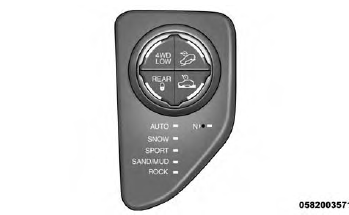Jeep Cherokee (KL): Shifting Procedures
With the vehicle at speeds of 0 to 3 mph (0 to 5 km/h), the
ignition switch in the ON position and the engine running,
shift the transmission into NEUTRAL, and push the
"4WD LOW" button once. The "4WD LOW" indicator
light in the instrument cluster will begin to flash and
remain on solid when the shift is complete.
NOTE: If shift conditions/interlocks are not met a message
will flash from the Electronic Vehicle Information
Center (EVIC)/Driver Information Display (DID) with
instructions on how to complete the requested shift.
Refer to "Electronic Vehicle Information Center (EVIC)/
Driver Information Display (DID) in "Understanding
Your Instrument Panel" for further information. With the vehicle at speeds of 0 to 3 mph (0 to 5 km/h), the
ignition switch in the ON position and the engine running,
shift the transmission into NEUTRAL, and press
the "4WD LOW" button once. The "4WD LOW" indicator
light in the instrument cluster will flash and go out
when the shift is complete. NOTE:Shifting Into 4X4 LOW

Selec-Terrain SwitchShifting Out Of 4X4 LOW
The preferred method is with the vehicle rolling 0 to
3 mph (0 to 5 km/h). If the vehicle is moving faster
than 3 mph (5 km/h), the 4WD system will not allow
the shift.
WARNING! You or others could be injured or killed if you leave
the vehicle unattended with the power transfer unit
in the NEUTRAL (N) position without first fully
engaging the parking brake. The NEUTRAL (N)
position disengages both the front and rear driveshafts
from the powertrain and will allow the vehicle
to roll, even if the automatic transmission is in PARK
(or manual transmission is in gear). The parking
brake should always be applied when the driver is
not in the vehicle. 1. Bring the vehicle to a complete stop and shift the
transmission to PARK.
2. Turn the engine OFF. 3. Turn the ignition switch to the ON/RUN position, but
do not start the engine.
4. Press and hold the brake pedal.
5. Shift the transmission into NEUTRAL.
6. Using a ballpoint pen or similar object, press and hold
the recessed power transfer unit NEUTRAL (N) button
(located by the selector switch) for four seconds. The
light behind the NEUTRAL (N) symbol will blink,
indicating shift in progress. The light will stop blinking
(stay on solid) when the shift to NEUTRAL (N) is
complete.
7. After the shift is completed and the NEUTRAL (N)
light stays on, release the NEUTRAL (N) button.
8. Start the engine.
9. Shift the transmission into REVERSE. 10. Release the brake pedal for five seconds and ensure
that there is no vehicle movement.
11. Shift the transmission to NEUTRAL.
12. Apply the parking brake.
13. Shift the transmission into PARK, turn the engine
OFF, and remove the Key Fob.
Repeat steps 1-7 to shift out of NEUTRAL.NEUTRAL Shift Procedure

Neutral Switch
 1-Speed Four-Wheel Drive (4X4). 2-Speed Four-Wheel Drive (4X4). Shift Positions
1-Speed Four-Wheel Drive (4X4). 2-Speed Four-Wheel Drive (4X4). Shift Positions
 Rear Electronic Locker (E-Locker) System - If
Equipped
Rear Electronic Locker (E-Locker) System - If
Equipped
Other materials:
CCD bus (+/-) circuits-pcm outputs. Data link connector-pcm input and
output. Fuel injectors-pcm output
CCD bus (+/-) circuits-pcm outputs
OPERATION
The Powertrain Control Module (PCM) sends certain
output signals through the CCD bus circuits.
These signals are used to control certain instrument
panel located items and to determine certain identification
numbers.
Refer to Group 8E, Instrumen ...
